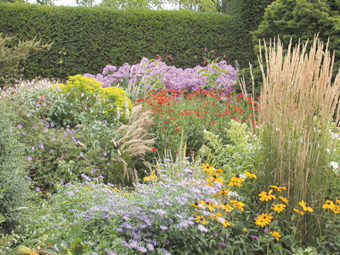|
COVER STORY | IN
THE NEWS December 28, 2006
New Year's Resolutionsby AMY STEWART I 've been gardening on the same piece of land for six years now, and you'd think I'd have everything figured out. But the garden is still a place of constant change, as I try to figure out Eureka's weather, its soil and even its butterfly and bee population. I worked for years to build the front yard into
a fabulous spring and summer cutting garden. Just as it hit its
peak, I decided that its blooming season was far too short, and
winter was far too long. Most of my flowering perennials needed
to be cut down to the ground after they finished bl
I got tired of that, and decided that I wanted something that would look good when it was raining, and something that would be beautiful in the wind and the fog. I got inspired by the work of Dutch plantsman Piet Oudolf, who is known for his naturalistic designs and for his appreciation of a plant's full life cycle. I decided to start growing perennials that would look good even when they were half-dead, and I'm filling the front yard with ornamental grasses, asters, gaura and tall purple verbena. The back yard has gone through a similar transition as I've changed it from a vegetable garden to a flower garden to a garden of hardy shrubs and groundcovers that can survive the attention of four free-ranging hens. In light of all those changes, I hereby make the following totally unrealistic and foolhardy resolutions for 2007: Fill in the gaps. Too many parts of my garden still look unfinished. I'm guilty of too much impulse buying at the nursery; I'll buy some little plant that I can only tuck into some small, already-overcrowded space, and I don't stop to think about the spots that really could use a large shrub, a vine climbing over a free-standing trellis, or something else that can fill some serious space and finally make the garden look finished. (Hey, I told you these were going to be unrealistic resolutions!) Tackle the big projects. There's one section of my garden -- a narrow strip between the kitchen door and the neighbor's fence -- that I've never done much with. I feel guilty about it, because this spot leads into the garden and it really should look like something. But it's mostly in shade, and it's dry (unless I think to water it, which I don't) and I just haven't been inspired to do anything interesting there. But this year I am determined to find something that will thrive in this difficult spot, and to just plant dozens of whatever that may turn out to be. Easy, right? Cut wasteful spending. I know, this is starting to sound like a political platform. But as much as I love depositing a significant portion of my paycheck at our local nurseries, it occurs to me that I just might have enough plants by now. Taking cuttings, divisions and seeds from what works, and distributing those plants around the garden, just might be the better strategy for 2007. Besides, with all that extra cash, I can spend more on fertilizer, soil and tools. (That really does sound like a political platform!) Deploy some new strategies. I've heard organic gardening experts say that after four years of purely organic techniques, a garden will practically take care of itself. That's been true for me -- in part. My garden has such a healthy, diverse insect population that I rarely see pests like aphid or whitefly. The chickens eat the snails. Diseases rarely show up, and when they do, there's usually a good organic product like Serenade that will take care of them. But this year, I'm going to add a new product called Messenger (available at nurseries around town) to the arsenal. Messenger is a natural plant growth regulator made from a protein called harpin, which is usually found in bacteria that cause plant diseases. It works like a vaccine, stimulating a plant's natural immune system, causing it to grow, get stronger and fight off diseases more easily. Although it isn't certified as organic, most organic gardeners would feel good about using it as a safe alternative to pesticides and fungicides. Get some bees. Orchard mason bees, that is. A honeybee hive is probably more than I can handle, but orchard mason bees are native North American bees that are friendly, gentle and solitary, meaning they don't form colonies and they very rarely sting. You may already have some living in little crevices in wood around your garden, and if you do, you'll see them out in early spring, pollinating your flowers and trees long before those Italian honeybees get moving. You can buy a wooden bee house filled with mason bee larvae starting in February or March; once you get them set up in your garden, they'll hatch on their own. Some people buy new bees every year, especially if they have an orchard to pollinate, but it's entirely likely that your bees will settle in and raise little bee families of their own. Look for them in shops around town this spring, including Strictly for the Birds in Eureka, or check online at www.knoxcellars.com.
Send garden news to amystewart@northcoastjournal.com, or write in care of the Journal at 145 G St., Suite A, Arcata, 95521. COVER STORY | IN
THE NEWS Comments? Write a letter! © Copyright 2006, North Coast Journal, Inc. |


